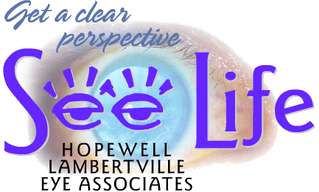What is a scleral lens and why does it work so well with many ocular conditions?
A scleral lens is a large diameter lens made of a highly oxygen permeable material. It does not move on the eye. It is not a contact lens in the strict sense of the word as it has no contact with the cornea. Instead, a liquid reservoir of sterile saline solution fills the space between the back surface of the lens and the front surface of the cornea. This liquid reservoir fills in the surface irregularities of the cornea allowing vision to be restored in a comfortable manner.The lens and the fluid liquid bandage beneath it protect the cornea from exposure to the environment and the rubbing effects of blinking. This cushion of fluid beneath the lens also provides oxygen to the cornea allowing the eye to heal. The effect is to create a smooth optical surface over the diseased or compromised cornea that replaces the distorted surface. Almost all of the time, vision and comfort are improved dramatically.
How large are the scleral lenses that you use and do the lens diameters vary according to the different eye conditions?
The lens diameters used do vary according to the diameter of the cornea, and the type of ocular condition that we are treating. For example, low degrees of keratoconus can be treated with a scleral lens of about 15mm in diameter. Some eyes that have undergo corneal transplant surgery may require a lens of 20 mm in diameter. Every eye is different and must be treated as a stand alone project.
What eye conditions are best treated with a scleral lens?
There are a number of eye diseases and conditions that are best treated with a scleral lens. What must be appreciated is the fact that a scleral lens, when fit correctly is a medical device and a therapeutic device all in one. The lenses that we design can be fit to virtually any eye shape and for any degree of visual error while at the same time allowing the diseased or injured eye to heal. Common conditions include, but are not limited to:
- Keratoconus
- Pellucid Marginal Degeneration
- Post-refractive surgical complications due to LASIK, Radial Keratotomy (R-K) surgery, PRK,ALK, CK, and so on. Many of these complications include distorted and fluctuating vision, halos,light sensitivity, reduced vision at night and indoors, glare, halos, star bursting, ocular pain, chronic dry eyes and so on.
- Complications resulting from corneal transplant surgery such as irregular, distorted corneas,chronic dry eye and unstable vision.
- Post-LASIK corneal ectasia. At one time it was thought that corneal ectasia was a rare risk factor for LASIK. In reality, we are seeing more and more patients suffering vision loss due to post-LASIK ectasia and other side effects from LASIK years after the surgery was done.
- Chronic dry eye due to systemic disease, medications and a variety of ocular conditions.
- A variety of corneal and ocular conditions such as Stevens-Johnson Syndrome, Sjogren’s Syndrome, corneas damaged as a result of ocular trauma, corneal degenerations and dystrophies,chemical and burn injuries to the eye, and adjacent ocular structures, eyelid abnormalities, aniridia and many other diseases and conditions.
Can I wear scleral lenses continuously?
Can I sleep while wearing my scleral lenses?In general, most eye care providers recommend that you remove scleral lenses before sleeping. Stagnation of the tear layer behind the lens could lead to a higher risk of eye infection. Since most of the people who need scleral lenses have already had some trouble with their eyes, further challenge to the surface of the eye would not be advisable.
In some cases, scleral lenses may serve to protect the surface of the eye overnight. In such cases, overnight wear may be specifically recommended by an eye care provider. However, if your eye care provider doesn’t specifically tell you to wear the lenses overnight, plan to remove them before retiring for the evening.
How long can I wear scleral lenses during the day?
Many patients who wear scleral lenses are able to wear them for 12-14 hours daily. Some patients may need to remove the lenses, clean them, and reapply them with fresh saline periodically throughout the course of the day in order to maintain the best possible vision and comfort.
Will scleral lenses completely correct my vision so that I don’t need glasses when I’m wearing them?
Scleral lenses will mask irregularities on the surface of the eye, and may give you better vision than other forms of correction. However, it’s possible that you’ll still need to wear glasses over the lenses in order to see clearly at all distances, especially if you’re over the age of 40 and are now using reading glasses for near tasks.
Corneoscleral lenses designed to reduce your dependence on reading glasses are available.
I have dry eyes. If I wear scleral lenses, will I be able to stop using eyedrops and/or other medication for my dry eyes?
Scleral Lens are perfect for the dry eye patient.Scleral lenses are a useful addition to your current therapy, but are not likely to completely replace other things that you’re doing to manage your condition. While scleral lenses protect the cornea, the back of your eyelid will still need to move over the front surface of the lens. Lubricant drops can help to reduce irritation caused by this interaction.
A gas permeable scleral lens replaces the cornea as an optical surface. It does not matter how distorted your corneas are. A well fitted scleral lens gives you the equivalent of a new cornea. As far as dryness issues are a concerned, the bowl of the scleral lens is filled with unpreserved saline solution. When placed on your eye, the lens does not touch your cornea. A liquid reservoir of pure saline solution fills the space between the back surface of the lens and the front surface of the cornea. In other words, your corneas are always in a moist environment.
If you are using any medications prescribed to manage corneal infection or inflammation, you should continue to do so when wearing scleral lenses unless your eye care provider specifically instructs you to discontinue the medication. Furthermore, you should plan to remove scleral lenses before using prescription eyedrops, and reapply the lenses after instilling the drops.
I have scleral lenses, and notice that my vision seems a little blurry after several hours of wear. What causes this, and what can I do to prevent it?
Blurred vision that you notice after a few hours of wear could be due to deposits on either the front or back surface of the lens. Removing the lens, cleaning it, reconditioning the front surface, and reapplying it with fresh saline should clear your vision. If your vision remains blurred even after cleaning and reapplying the lens, check with your eye care provider to make sure that your lens is still fitting properly.
How long will a scleral lens last?
Depending upon your tear film’s tendency to coat the lenses and your care habits, scleral lenses should last approximately as long as other rigid lenses (1-3 years).
How Do Scleral Lenses Differ From Corneal Lenses?
Corneal or conventional gas permeable lenses are designed to fit on the corneal surface and parallel the ocular surface of the cornea. A gas permeable scleral lens vaults over the cornea and is supported by the white portion (the sclera) of the eye. A properly fit scleral lens will not touch the cornea unlike a corneal lens. With a scleral lens, the space between the back surface of the lens and the front surface of the corneais filled with sterile, unpreserved saline solution. In other words, the irritated, compromised cornea is always in a liquid environment. A corneal lens can rub against a compromised cornea and have a traumatic effect on the delicate tissue.
There are many corneal and ocular conditions that prevent patients from seeing the world clearly. Many patients with these conditions cannot be made to see clearly with eyeglasses or conventional contact lenses.These conditions include, keratoconus, autoimmune disease, eyes with corneal transplants and eyes that have undergone refractive surgical procedures such as LASIK and Radial Keratotomy. Scleral lenses can allow almost all of these patients to see clearly and comfortably once again. Indeed, a scleral lens is the only technology that will allow almost all of these patients to see clearly and comfortably once again while at the same time protecting the compromised cornea and allowing a healing action to take place.
Why Are Scleral Lenses More Comfortable Than RGP Corneal Lenses?
There are a number of reasons for this including:
- Scleral lenses do not move over the compromised cornea. Instead, these unique lenses vault over the cornea and are supported by the white portion of the eye, known as the sclera. The space between the back surface of the lens and the front surface of the cornea is filled with sterile saline solution.
- Patient suffering loss of ocular comfort due to keratoconus, post-LASIK complications and other ocular conditions and diseases, have severely compromised corneal surfaces. Corneal RGP lenses rest on top of this cornea cornea and move over the irritated corneas with each blink of the eyelids. This lens movement can create additional damage to these irritated corneas.
- Because the scleral lenses fit under the eyelids, there is no lid awareness when blinking as the eye lids pass over the smooth surface of the scleral lens.
- Because so many of these eyes are very dry and irritated, corneal lenses can make this condition worse.The space between the back surface of the scleral lens and the front surface of the cornea is filled with unpreserved saline solution. Because of this, dry, irritated corneas are always in a wet environment.
Are There Any Complications Associated With Scleral Lenses?
Like any foreign object placed on our bodies, certain rules and protocols need to be followed in the use of scleral lenses. These are:
- To reduce the risk of eye irritations and infections, scleral lenses must be cleaned with a special cleaning solution after they are worn at the end of the day. Our office provides our patients with this lens cleaner.
- A special unpreserved sterile saline solution must be used when inserting scleral lenses. This saline solution is used to fill the bowl of the lens upon insertion. Using tap water or a preserved solution can create complications including infection. We provide this preservative saline solution to all of our scleral lens patients.
- We recommend that a protein removing solution be used on the lenses once each month. The ocular secretions that we all produce are protein in nature. Over time these proteins can adhere to the lens surfaces and can create eye irritations and reduced vision. Our office provides our patients with this protein remover.
- Hygiene is extremely important when working with scleral lenses. We recommend that our female patients apply their makeup after inserting their scleral lenses. The scleral lens case should be replaced on a monthly basis and cleaned daily. In addition, the lens conditioning solution placed in the case with the scleral lenses should be replaced daily. Of course, patients must wash their hands thoroughly prior to inserting and removing their scleral lenses.
- If the above protocols are followed, the risk of ocular complications are extremely small. The patients who I have provided scleral lenses to are “high need” patients. That is, this population has lost vision and ocular comfort due to refractive eye surgeries such as LASIK, Radial Keratotomy, PRK, keratoconus, corneal transplant surgery and so on.
- Most of this patient population have very dry eyes and a compromised ocular surface. The scleral lenses that we design for our patients protect the compromised cornea from the environment and from the blinking action of the eyelids. In addition, because the corneas are always in a liquid environment,these unique lenses act as a therapeutic device




